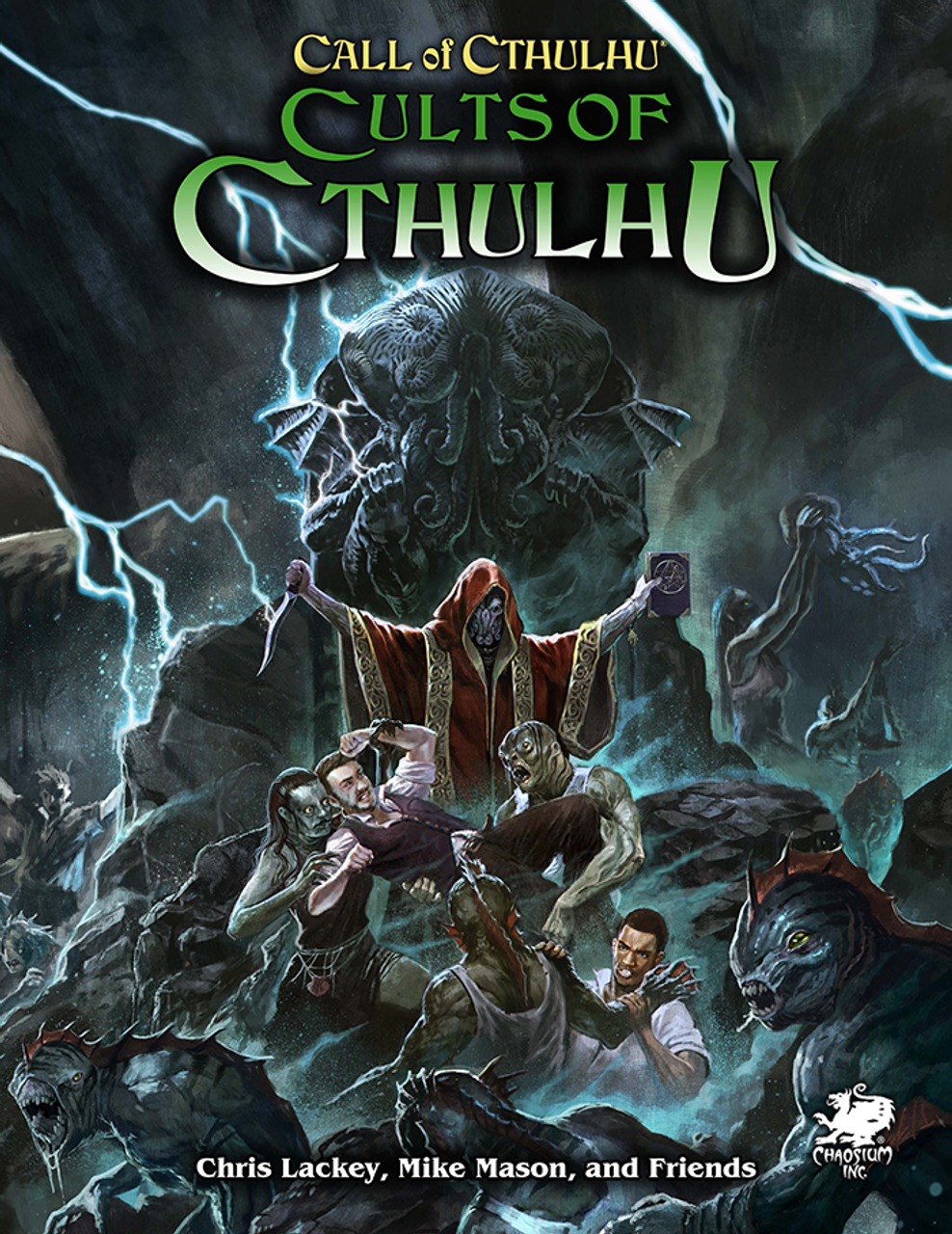Cults of Cthulhu is one of Chaosium’s more ambitious recent offerings, but what’s it all about? Well, it provides a comprehensive overview of the Cthulhu cult but, perhaps more importantly, gives Call of Cthulhu Keepers a structured process for creating and breathing life into cults of their very own. Keepers don’t have to do all the work, though: the book describes five Cthulhu cults in exhaustive detail (and I mean down to the stat block), and contains three scenarios to boot, spanning the gaslight, classic, and modern eras. No matter the game you’re running, there’s a Cthulhu cult sitting here in this book, ready to go. Clocking in at 335 pages, this is a tome of horrors (pardon the pun). There’s more material lurking between the covers than you can poke a tentacle at – so much so, in fact, that you’re probably going to have to pick some up. Shall we take a stroll though the chapters? Let’s!

History of the Cthulhu cult
The book opens by taking us through the pseudo-history of the Cthulhu cult from 2000 BC to the present day, as told by the fictitious Mildred Schwartz. This section serves as a collection of ideas and inspiration for your own cults and their possible origins. What initially looks like a fluffy or pointless chapter transmogrifies into pure gold as it becomes clear just how many ideas and plot hooks are being laid down for a Keeper to use. The chapter offers brief descriptions of no less than 32 Cthulhu cults across recorded history, so the scope for inspiration is enormous.

Cults
Five Cthulhu cults are described in detail, including their history, beliefs, financial and social structure, and goals. Key members are described, and there’s even helpful hints on possible storylines to use or possible changes you could make to use the cult in your own games.
Two of the cults were created by Lovecraft himself: The Esoteric Order of Dagon, from The Shadow over Innsmouth, and The Louisiana Swamp Cult, from The Call of Cthulhu. The remaining three are novel. Of the five cults, three were founded in the 19th century, one was founded in the 1920s and another is modern. All of that means the GM has options: Lovecraft’s own creations or something else, as well as a choice between the Gaslight, Classic, or Modern settings. What’s more, you’re provided with ways to hack the cults as written to make them fit your game, whatever setting you’re using. Handy.

Creating a cult
Takes you through the process of constructing a cult by creating an its organisational and financial structure, its relationship with the Mythos and, importantly, its weaknesses and enemies. This gives a cult depth and believability. It includes example cult worksheets and suggestions for creating organisational charts to make the job of creating a cult easier and more straightforward. A bonus is that the worksheets are pre-filled, giving you a couple of bonus cults (the blank ones are at the back of the book).
Cultists, monsters and artifacts
In this chapter, we leave the big picture and get into the nitty-gritty stuff that you’ll want to know in order to create a fleshed-out, convincing cult. We’ve got cultist archetypes, from your basic goon to the cult leader. There are Cthulhu’s blessings, or boons bestowed by the sleepy one himself. There’s a section on the Deathless Masters, immortal Uber Cthulhu-influencers, including two examples you could use in your own games. We have 3 monstrous cultists, 5 monsters, and new artefacts and spells. It’s a lot of stuff.

Scenarios
Towards the end of the book, you’ll find three scenarios. The first, Loki’s gift, is set in the gaslight era London, and centres on the apparent suicide of a talented young musician. This scenario delves into the dark side of the arts and of 19th century society. The second instalment, Angel’s Thirst, set in 1920s Los Angeles, involves a missing taxi driver and explores themes of religion, family, community and the ways in which they can all be perverted towards dark ends. A God’s Dream, the last of the three, is a modern scenario in which the investigators attempt to locate a friend in Chicago. In this scenario, the power of technology to create wealth and influence is at the fore. Frank Zuckerberg, eat your heart out.
These scenarios can be run separately or strung together to form a mini-campaign. The Chaosium website has supplemental pdfs for the maps and handouts, as well as NPC portraits, and a keeper reference booklet with all the stat blocks in a handy document. Did I say it’s a lot of stuff? It’s a lot of stuff.
To say this book has it all is an understatement. Any Cthulhu fan would have to be crazy not to get it, but there’s value in it for those who are less than enthused by The Sleepy Green Dream-sender. Let’s face it; cults are fun, and whether yours worships The Goat with a Thousand Young, The Crawling Chaos, or He who Shall not be Named, this book contains the means to make it realistic, dynamic and memorable. Recommended.
Get Cults of Cthulhu here: https://www.chaosium.com/cults-of-cthulhu-hardcover/
Do you prefer the King in Yellow? Check out Heinrich’s Guide to Carcosa.
Looking for some extra scary scenarios to run? Check out Nameless Horrors, Blackwater Creek, or Fairyland.


Leave a Reply
You must be logged in to post a comment.